3D Truss Models
-
View model here:
3D Warehouse
3D Warehouse is a website of searchable, pre-made 3D models that works seamlessly with SketchUp.
(3dwarehouse.sketchup.com)
Using the hip rafter roof as a template it won't be too hard to add the octagon and circular roof, two more checkboxes to fill. I do admit that sometimes I like the low hanging fruit, but it is really the challenging stuff that piques my interest and drives me.
I've had a bit of a cold all night, tempted to call in sick and spend the rest of the day coding but my wife would probably kill me if I did.
-
Working on adding in the inset floor joists per the details given by dpaul:
Parameters are the following:
1.) Stemwall Thickness (inset amount)
2.) Ledger Option: Yes or No
3.) Ledger Height
4.) Ledger Width
5.) Hanger Option: Yes or NoI'm still waffling on what to do if the hanger option is "yes". I was considering having the option of selecting one of the many Simpson-Strongtie hangers from a long list of hangers. However, no models exist for the bulk of these hangers and I don't have the time or data to try and model a bunch of them. Item 5 may not be feasible.
I also have a question on the ledger board option:
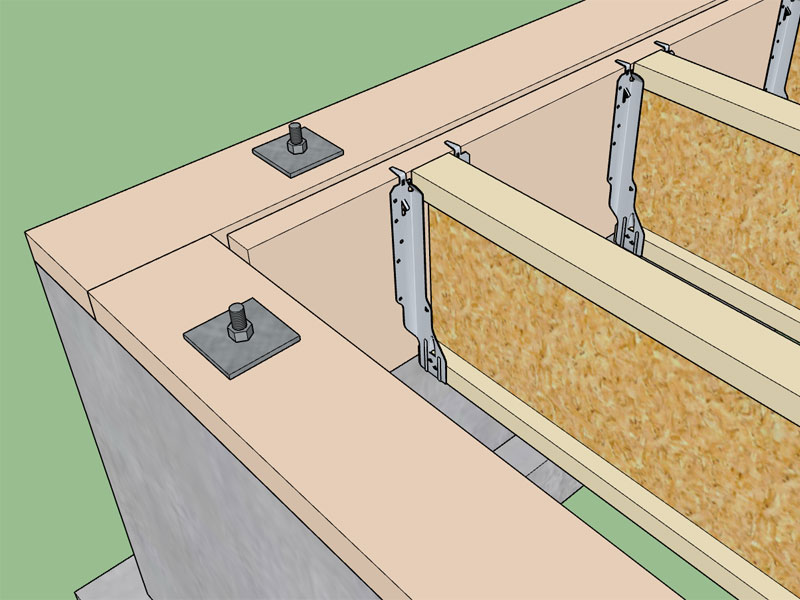
As you can see in the image the 2x12 PT dimensional lumber ledger is smaller in height (11.25") than the 11-7/8" TJI. In this case would the ledger be run flush to the bottom of the TJI or is this not a concern? I was thinking that one would probably call out an LVL or LSL ledger with felt backing between the ledger and the concrete so that the ledger matches the height of the I-joist. Additional information when the floor joists are I-joists or EWP would be helpful here.
View model here:
3D Warehouse
3D Warehouse is a website of searchable, pre-made 3D models that works seamlessly with SketchUp.
(3dwarehouse.sketchup.com)
-
Someone suggested that I try out Patreon rather than Kickstarter:
-
Medeek,
Interesting approach of having pledges towards a monthly salary that you have set to allow you to
develop your plugins full time.One question I have is how long do the "Patrons - pledges" last?
Is it set by a time limit or a predetermined stage in your plugin development?Following with interest, best of luck!
Regards,
Ray -
@facer said:
Medeek,
Interesting approach of having pledges towards a monthly salary that you have set to allow you to
develop your plugins full time.One question I have is how long do the "Patrons - pledges" last?
Is it set by a time limit or a predetermined stage in your plugin development?Following with interest, best of luck!
Regards,
RayI haven't read through all of the details on Patreon's website but there does not appear to be any time limit on the pledges, each patron can stop their patronage at any time.
Realistically, I am thinking a couple of years should be enough time to advance the development to the stage where the momentum and plugins will carry themselves.
-
Version 2.0.0b - 10.01.2017
- Enabled roof cladding for shed and shed w/ ledger rafter roofs.
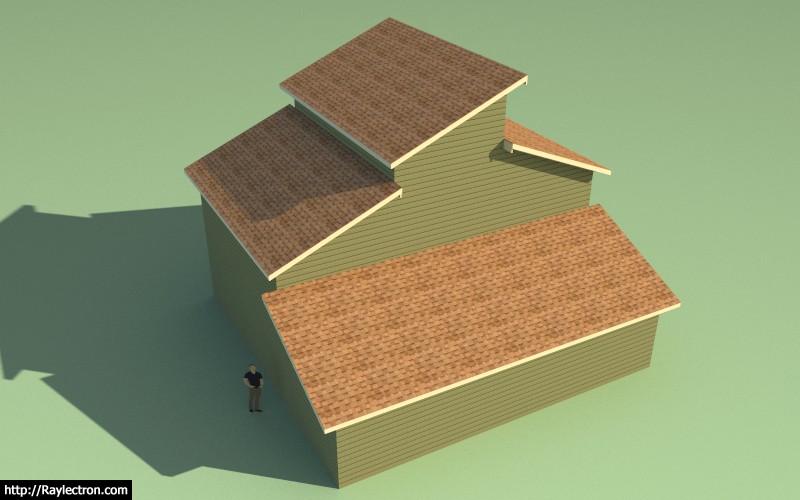
View model here:
3D Warehouse
3D Warehouse is a website of searchable, pre-made 3D models that works seamlessly with SketchUp.
(3dwarehouse.sketchup.com)
-
Version 2.0.0 - 09.30.2017
- Added a hip & ridge option for dutch gable rafter roofs.
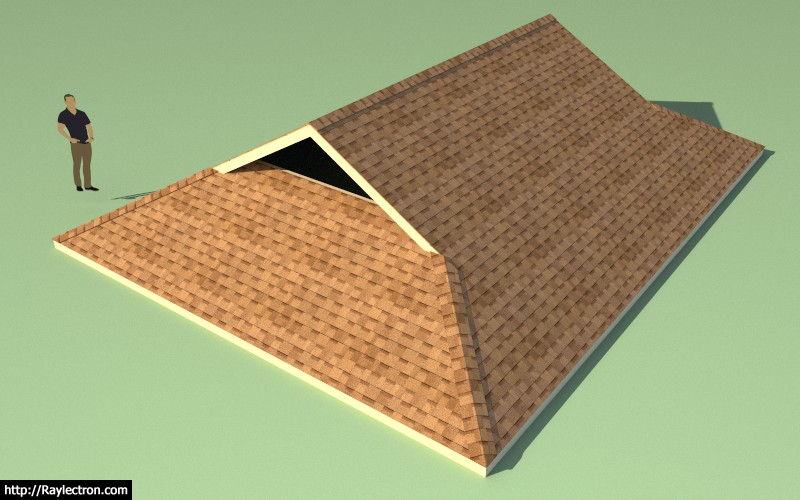
View model here:
3D Warehouse
3D Warehouse is a website of searchable, pre-made 3D models that works seamlessly with SketchUp.
(3dwarehouse.sketchup.com)
Not exactly how I should terminate the hip cap where it meets the gable section of the roof. What I have now seems reasonable enough for presentation and estimating purposes.
Quite a bit of convoluted code to get those sections of hip cap just right, where there is a will there is a way.
-
Version 2.0.1 - 10.04.2017
- Added (FULL) roof return option within the advanced options menu for common, scissor and vaulted trusses.
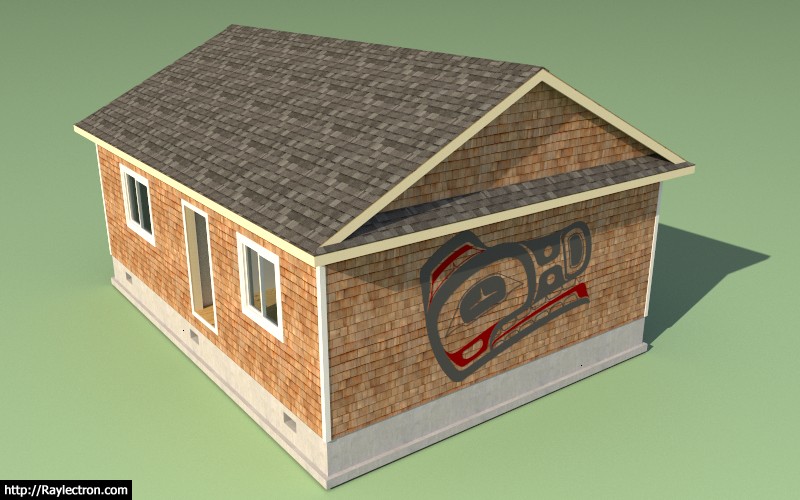
-
I'm not entirely sure how one frames up a full "greek" return or cornice. When you strip away the sheathing and cladding you can see that my rafters don't line up well with anything:
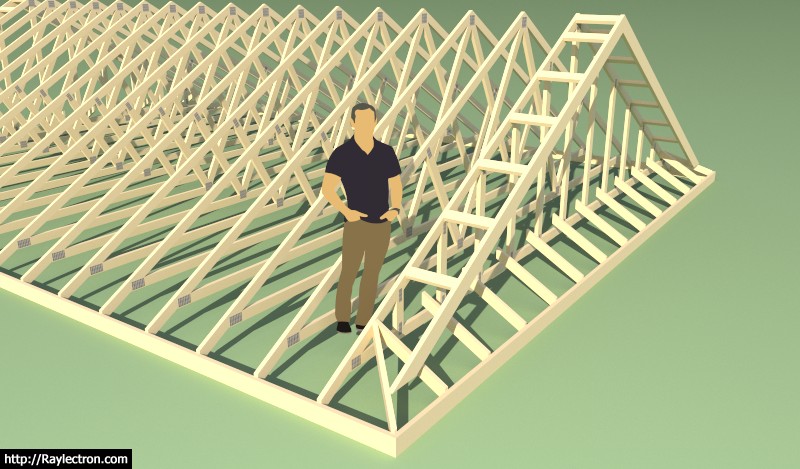
-
I'm considering selling my plugins and code, I won't divulge the potential buyer(s) but I have really no idea how much it is worth, I suppose that is purely subjective. If you have a suggestion please feel free to message me.
-
Version 2.0.1b - 10.06.2017
- Added ceiling joist option for Hip Rafter Roofs.
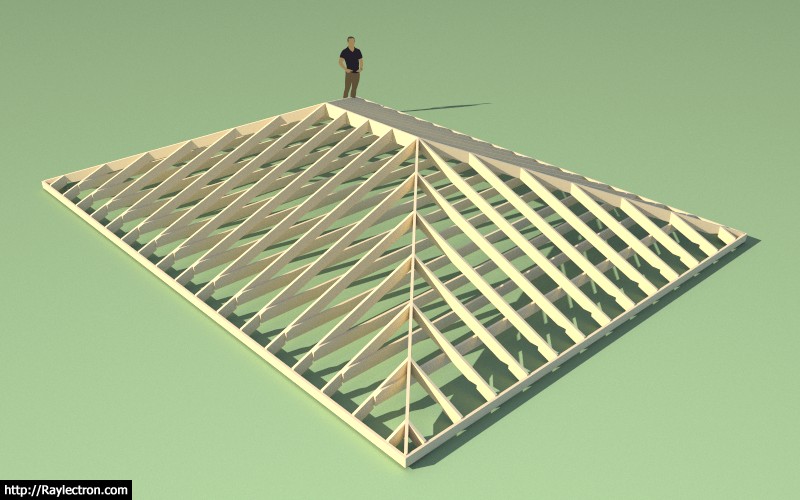
-
Inset floor joists for sawn lumber and I-joists is now running, (with and without ledger). I will need to test it further and then roll a new revision:
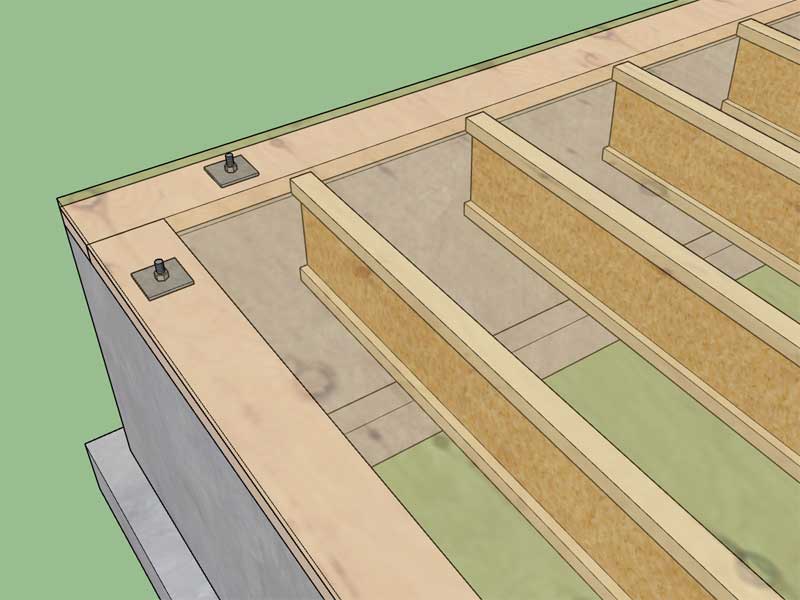
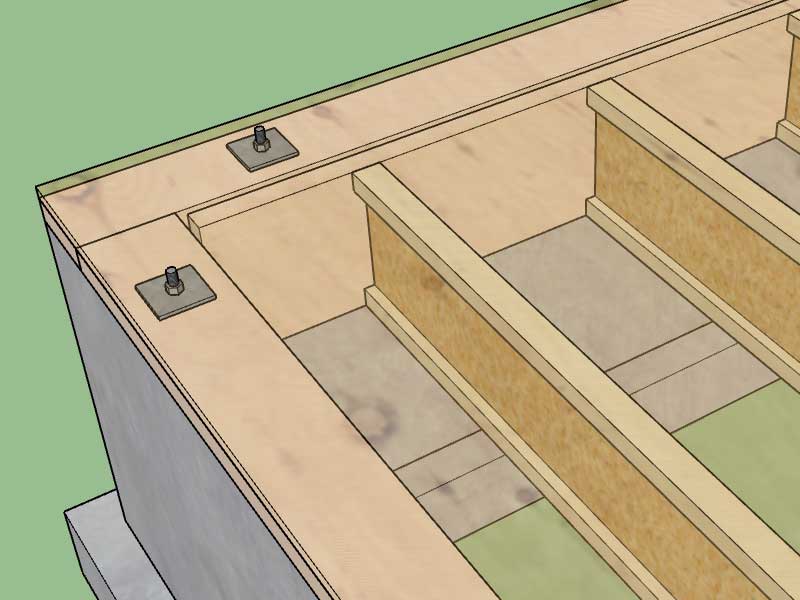
-
Version 2.0.2 - 10.07.2017
- Added the option to inset floor joists with ledger.
- Added the option to inset floor joists without ledger.
I just realized that today is the two year anniversary of the Truss Plugin, crazy to think that I've already been working on this thing for two years. Progress has been incremental but fairly steady. There are still some big obstacles and goals ahead.
The new inset option also works well if you are using joist pockets in the foundation:
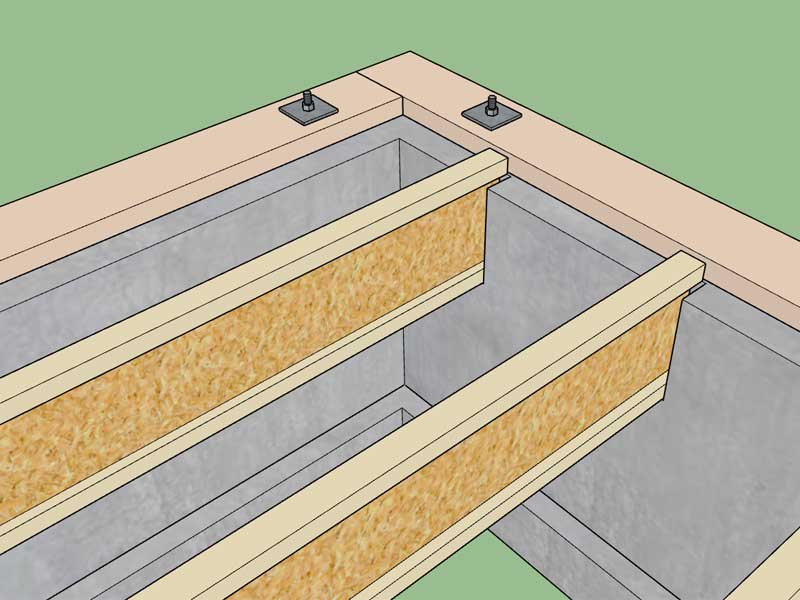
This model was created with the Truss Plugin and the Foundation Plugin. Foundation wall is 8" thick with the pockets set at 2.25" deep and the bearing length of the joists set at 2". The floor sheathing layer is turned off for clarity.
View model here:
3D Warehouse
3D Warehouse is a website of searchable, pre-made 3D models that works seamlessly with SketchUp.
(3dwarehouse.sketchup.com)
-
Great looking work! I don't know how you even did it in 2 years!
-
Version 2.0.2b - 10.07.2017
- I-Joists are branded with respective manufacturer's logo.
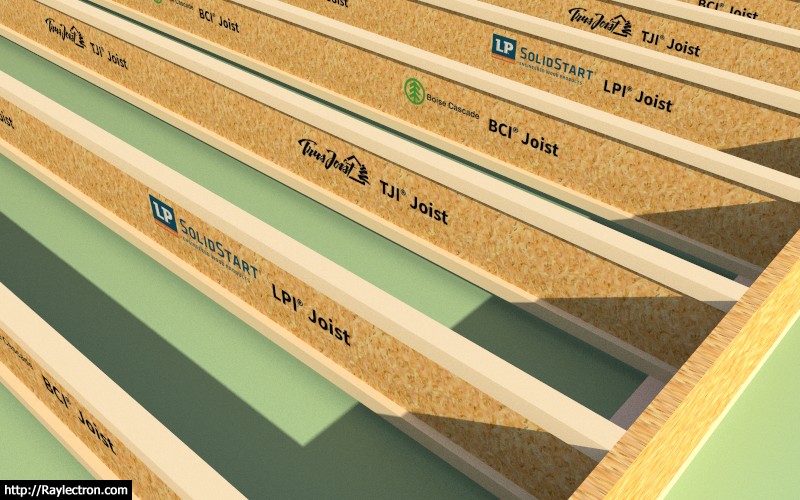
View model here:
3D Warehouse
3D Warehouse is a website of searchable, pre-made 3D models that works seamlessly with SketchUp.
(3dwarehouse.sketchup.com)
-
This morning I've spent some time reviewing my roadmap and my "todo" list. I'm still working on the straight skeleton implementation, and that is the big one right now. The small upgrades and fixes I've released over the last few days have been some low hanging fruit that I've gravitated towards to break up my heavier coding sessions. Its rewarding to achieve a few small victories and push them out when your bogged down and progress seems retarded.
The plugin as a whole has quite of bit of functionality but it also is very limited in many respects. This really jumps out at me when I try to model up some recent homes that I did structural work on a few months ago. The biggest issues seem to be:
- Inability to cut holes in floors or create polygon floor outlines.
- The same issue with roofs in that the plugin is only really good at rectangular roof outlines. The straight skeleton implementation will address this, at least for rafter roofs initially, truss roofs will be a much bigger problem.
- There is no function for editing a roof or floor assembly, it's fire and forget. This feature would be particularly useful when you botched one parameter and just need to go back and edit something minor rather than recreating the entire assembly (not that this is too difficult).
- I'm missing a good staircase creator/editor.
- Not all of the truss types are up to speed with all the recent advanced options, so much to do.
- The manual is almost non-existent.
The list of limitations goes on. The plugin has potential but its certainly a work in progress and far from the polished gemstone it needs to be.
With all that being said I feel like moving my price to $40.00 was and is probably a bit of an over reach. Personally I would not pay that amount for the functionality offered, its too much. I've dropped my price back down to $30.00 and the renewal price is now $20.00, hopefully this is more commensurate with the amount of functionality and utility offered.
At some point in the near future when I have fully addressed most if not all of the above issues then I will look at raising the price to its former level.
For those users who purchased the plugin at the $40.00 price I have no problem in extending your license a pro-rated amount. Please feel free to email me with your request for the license extension.
-
With the inset joists I thought it would be really cool to have the plugin be able to auto-select the correct joist hanger and insert it at both ends of the I-joist or sawn lumber. I quickly modeled up a simplified version of an IUS1.81/11.88 Simpson Face-Mount I-Joist hanger and with the addition of one simple function I was able to do this:
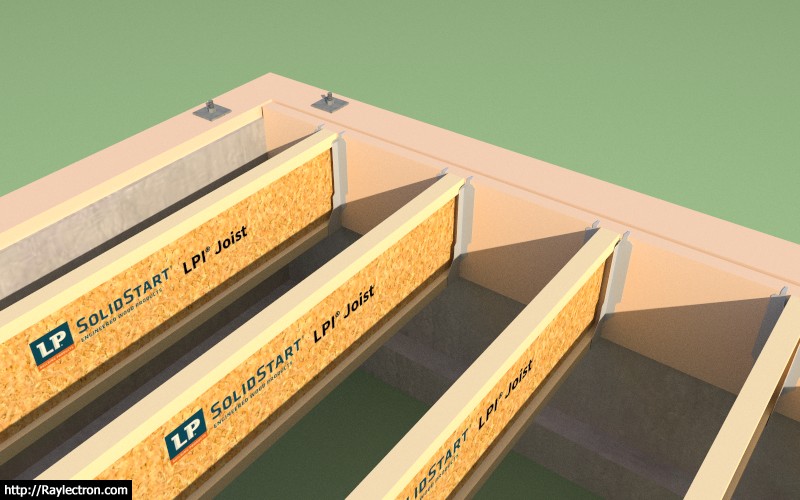
View model here:
3D Warehouse
3D Warehouse is a website of searchable, pre-made 3D models that works seamlessly with SketchUp.
(3dwarehouse.sketchup.com)
I haven't yet released this most recent addition because I only have two sizes of hangers created so far. There are five typical flange widths and the following typical I-joists depths: 9.5, 11.875, 14, and 16. So if you do the math I need to model 20 different face mount I-Joist hangers and 20 top flange I-joist hangers (IUS and ITS series). For sawn lumber a similar situation exists for 2x6, 2x8, 2x10 and 2x12 joists.
I was considering using the official Simpson models from the 3D Warehouse but they are too complex, a minimalistic hanger gets the point across just as well.
When I get home from work I usually only have a couple hours to hammer away at things so some more low hanging fruit gets picked.
I just realized that I have no idea what I-joist and hanger (metric) sizes exist for the UK and Australian markets, can someone point me in the right direction for some literature.
-
Medeek,
You may get some ideas by checking out:
http://www.tilling.com.au/framesmartThey also have a free program called "Smartframe" that is
part of their marketing strategy to professional.TIMBER SIZES - METRIC - AUSTRALIA
https://www.tilling.com.au/product-type/smartframe/
-
The IUS hanger family:
3D Warehouse
3D Warehouse is a website of searchable, pre-made 3D models that works seamlessly with SketchUp.
(3dwarehouse.sketchup.com)
I was going to release the latest version but the SketchUp signing page is down again.
p.s. And now it up, 2.0.2c has the hanger update with all twenty (20) IUS hangers for I-Joists ranging from 9.5 to 16 inches deep.
-
After giving it much thought I've decided that selling my plugins would be a bad idea. They've literally become a part of me, who I am and what I do. To part with them would leave a hole, so in the end this becomes an emotional decision for me rather than one that is solely based on monetary gain.
The Medeek plugins will continue as they are for the foreseeable future.
I've also noticed sales of the plugin has completely dried up over the last two weeks, I don't know if this because I was considering the sale of my plugin or if is indicating a saturation point. It does make me wonder if lowering the plugin price even further would drive a larger volume of users.
Lets say for example I lowered the price to $10.00, would I then expect a double or triple increase in sales? When I look at the number people who have actually installed the plugin it is well over 10,000 now, and I only started keeping track about a year ago, so the number could easily be double that. If the price was lower ($10.00) could I get at least 10% of the installed base to upgrade to a registered version, if so this type of marketing makes sense.
But then again perhaps I have hit an actual saturation point, where "real" users have all been potentially exposed to the plugin and everyone else is just testing it out but never will purchase it for serious use.
Ultimately, I am just trying to find a way to monetize my efforts more and somehow enable myself to spend even more time developing this plugin and all of others I've started cooking up.
Advertisement








